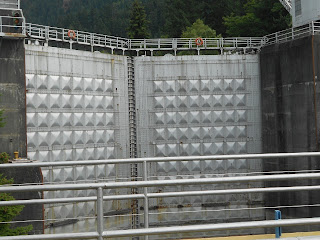 |
| Bonneville Dam |
The Bonneville Dam, located about forty miles east of Portland Oregon, is a great travel stop for the entire family. Not only do the exhibits at the Bonneville Dam explain how the dam operates and produces hydro-electric power, but also how the fish of the Columbia River navigate themselves upstream past the dam to spawn. It's really a fascinating story and the way it's presented at the Bonneville Dam visitor center is quite unique and entertaining.
A trip to the Bonneville Dam is an excellent addition to your Columbia River Scenic Highway sightseeing agenda.
The Great Challenges of Building the Bonneville Dam
The U.S. Army Corps of Engineers has been involved in the
Columbia River Gorge since the late 1870’s. It was then that they constructed the Cascade Locks. The locks were badly needed to help improve Columbia River navigation past the Cascade Rapids. When some of the early Oregon Trail pioneers chose to proceed down the Columbia River in the 1840's, the river's rapids were quite a challenge, often times a deadly one.
See our Western Trips photos and article on Oregon City, the end of the historic Oregon Trail.
The Bonneville Dam was constructed in 1938. Construction time took about five years. It's second power house was added in 1982. The dam is owned by the U.S. Army Corps of Engineers. It is the first of eight locks and dames along the Columbia and Snake Rivers. Finding a suitable location to erect a dam can be difficult. In the case of the Bonneville Dam, the site chosen had ample bedrock to provide the all important foundation for the dam. Construction of the dam presented many challenges. These included the
depth of water, the speed of the river's current, the harsh weather conditions, and the
annual summer flood caused by mountain water runoff. In addition to these challenges, constructing the Bonneville Dam also meant that miles of roads and rail tracks would have to be relocated and massive timbers were employed to help divert water away from the construction site.
See our Western Trips photos and article on Oregon City, the end of the historic Oregon Trail.
 |
| Diagram of how a turbine operates to produce electricity |
At the time of construction, the Bonneville Dam was built for two initial reasons. One was to add jobs during the country's Great Depression. The other was to provide needed hydro-electricity to the Pacific Northwest. The proposal for a dam on the Columbia River was also a presidential campaign pledge of Franklin Delano Roosevelt.
 |
| Old turbine exhibit at Visitors Center |
Hydro-electric power at a dam is produced when water flows through it to the river below. A turbine is what actually produces the power as shown in the diagram. A turbine consists of metal coils surrounded by magnets. Electricity is made when the magnets spin around the coils. Obviously this is pollution free energy as opposed to coal fired generators.
The first power house built had 10 generators. These were brought online between 1938 and 1944 and had a generating capacity of 526,700 kw of power. The second powerhouse was constructed with eight generators that produced 558,200 kw. The hydro-electric power that the dam produces is sent to the Bonneville Power Administration grid. From there power can be sent to Oregon and Washington as well as a number of other northwestern states. Bonneville power had a big place in building America's northwest.
A Most Scenic Site
The Bonneville Dam is in the Columbia River Gorge which is arguably one of the most scenic areas in the United States. Driving there from Portland Oregon takes you along the Columbia River Scenic Highway constructed during the first part of the 1900's. On the way to visit the dam, tourists will pass by numerous falls and other historic sites which makes getting there a lot of fun.
 |
| Bonneville Dam locks door |
In 1986, the Bonneville Lock and Dam project was placed on the National Register of Historic Places and was later moved up to a National Historic Landmark.
Visiting the Bonneville Dam
Getting to the Bonneville Dam Visitors Center requires all people and cars to pass through a security gate. The Bonneville Dam visitor's center is a separate building from the main powerhouse. The Visitors Center contains many exhibits explaining just how the dam produces hydro-electric power ans specifically about the history of the dam itself.
 |
| Fish ladder at Bonneville Dam |
On the lower level you can view through a glass wall the fish actually making their journey upriver. Just outside the Visitor Center you can view the "fish ladder" which allows the fish to essentially climb the river. This also allows for a Bonneville Dam fish count. A fish ladder is a series of pools arranged in ascending steps at the side of a stream, enabling migrating fish to swim upstream around a dam or any other obstruction. It's really a fascinating thing to see and ensures that the Columbia River fish ecological balance is retained. Adjacent to the dam is the Bonneville Fish Hatchery.
In the Bonneville Dam Visitor Center you'll also see exhibits about the old area history dating back to the Native American days. These were the early days of the Lewis and Clark Expedition and several decades later the migration of thousands of pioneers over the old Oregon Trail.
The Bonneville Dam Visitor Center also offers guided tours depending on the season. The Bonneville dam tour is very informative and you can actually go into the electricity generation building there. Outside of the Visitors Center when you first arrive, take note of the large turbine wheel exhibit shown above from one of the original powerhouse turbines.
(Photos from author's private collection)
View Larger Map

